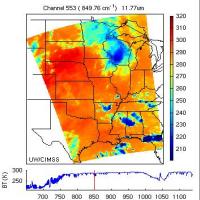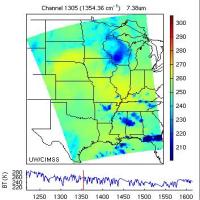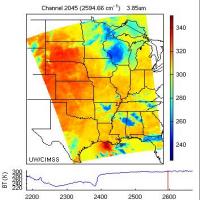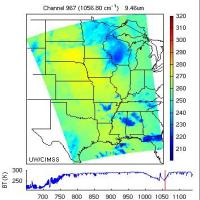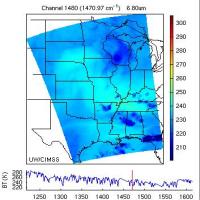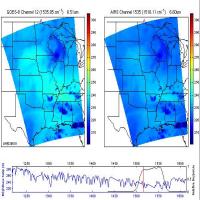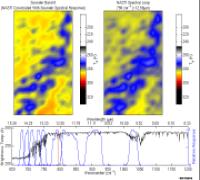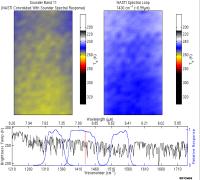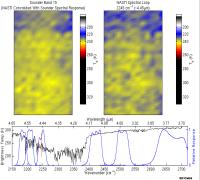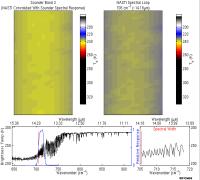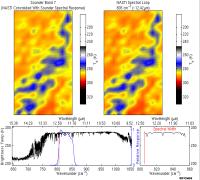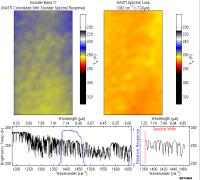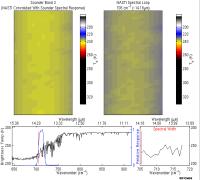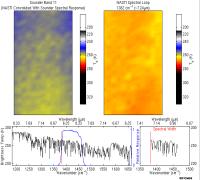Comments, questions on this web page? Send e-mail to: |
ABS/HES SimulationContents IntroductionThere are two main methods to simulate the expected signal for a future instrument. One method uses a radiative transfer model along with some estimate of the state of the atmosphere to calculate the expected (noise free) signal and then add noise. The second method, employed in this web page, is to use higher-resolution data to simulate ABS/HES. This method allows for more realistic simulations, especially of the clouds. We use the high-resolution AIRS and NAST-I data to simulate ABS/HES bandsThe following set of AVI-format animations were created at the
Cooperative Institute for Meteorological Satellite Studies (CIMSS)
to demonstrate the need for high spectral resolution satellite
data. The current GOES Sounder has 18 infrared channels and the
proposed ABS/HES would be a high spectral resolution instrument
covering the following wavelengths:
Simulation Based on AIRS DataThe following animations show a sample of the data which would be available from the proposed ABS/HES. These were created using AIRS level1b data set on July 20, 2002, 19:20 UTC. To simulate ABS/HES, all good quality AIRS IR channels are chosen in the proposed ABS/HES wavebands.Longwave, Midwave, and Shortwave BandsThe following animation shows the AIRS radiances converted to brightness temperatures (Kelvin) which simulates what will be seen with the ABS/HES longwave (650 - 1200 cm-1), midwave (1210 - 1740 cm-1) and shortwave (2150 - 2720 cm-1) spectral regions.
(Click to view in browser or right-click and
choose "Save Link As..." to download)
Note: The image on the top of the animation displays the AIRS radiances converted to brightness temperatures (Kelvin) which simulates what will be seen with the ABS/HES. The figure on the bottom displays FOV-mean brightness temperature and the red line indicating the current band shown on the top. CO2, O3 and HO2 BandsThe size of the AVI-format movie files is rather large, the bands in the carbon dioxide (690 - 790 cm-1), ozone (980 - 1080 cm-1) and water vapor (1450 - 1550 cm-1) are extracted to reduce download time.
(Click to view in browser or right-click and
choose "Save Link As..." to download)
GOES-8 Sounder Band 12 and Corresponging AIRS BandsThe following AVI movie shows AIRS high-resolution measurement with the GOES-8 band 12 (around 6.7µm water vapor) band.(Click to view in browser or right-click and
choose "Save Link As..." to download)
Note: The image on the right side of the animation displays the AIRS radiances converted to brightness temperatures (Kelvin) which simulates what will be seen with the ABS/HES. The image on the left side displays AIRS radiances convolved over the current GOES-8 Sounder spectral response function for the appropriate band and converted to brightness temperatures (Kelvin). Simulation Based on NAST-I Data (October 17, 2000)Longwave, Midwave, and Shortwave BandsThe following animations show a sample of the data which would be available from the proposed ABS/HES. These were created using high spectral resolution (~0.25 cm-1) NAST-I data. The NAST-I instrument was flown over Oklahoma on March 19, 2000; click here to see the flight path. To simulate ABS/HES, the spectra shown is sampled every 3 NAST-I data points for the longwave, every 5 for the midwave, and every 10 for the shortwave. The animations only display a data point every 5 cm-1; this is done to maintain a reasonable animation file size. Subsequently, this only simulates every 8th ABS/HES data point in the longwave, every 4th in the midwave, and every 2nd in the shortwave.
(Click to view in browser or right-click and
choose "Save Link As..." to download)
Note: The image on the right side of the animation displays the NAST-I radiances converted to brightness temperatures (Kelvin) which simulates what will be seen with the ABS/HES. The image on the left side displays NAST-I radiances convolved over the current GOES Sounder spectral response function for the appropriate band and converted to brightness temperatures (Kelvin). These images are centered over Oklahoma. Sounder Bands 3, 7, and 11For a more dramatic demonstration, Sounder bands 3, 7, and 11 were isolated to show how much spectral variability in the atmosphere exists within those bands which is currently being averaged over using the Sounder. To maintain a manageable file size, band 7 was sampled at every ~1.0 cm-1 and band 11 was sampled at every ~1.25 cm-1. Band 3 is shown at the NAST-I spectral resolution, which is approximately 0.24 cm-1 for this data set.
(Click to view in browser or right-click and
choose "Save Link As..." to download)
Note: The image on the right side of the animation displays the NAST-I radiances converted to brightness temperatures (Kelvin). The image on the left side displays NAST-I radiances convolved over the current GOES Sounder spectral response function for the appropriate band and converted to brightness temperatures (Kelvin). Special Note: These animations were resized on November 30, 2000 to be 720x544 pixels, which may facilitate viewing in a Powerpoint slide. Sounder Bands 3, 7, 11, and 14 at ABS/HES Spectral ResolutionIn the following animation demonstrations Sounder bands 3, 7, 11, and 14 are shown at the spectral resolutions planned for ABS/HES. This is ~0.625 cm-1 for bands 3 and 7, ~1.25 cm-1 for band 11, and ~2.5 cm-1 for band 14.
(Click to view in browser or right-click and
choose "Save Link As..." to download)
Note: The image on the right side of the animation displays the NAST-I radiances converted to brightness temperatures (Kelvin) which simulates what will be seen with the ABS/HES. The image on the left side displays NAST-I radiances convolved over the current GOES Sounder spectral response function for the appropriate band and converted to brightness temperatures (Kelvin). Special Note: These animations were resized on November 30, 2000 to be 720x544 pixels, which may facilitate viewing in a Powerpoint slide. Full IR Spectra (January 11, 2001)The following AVI animation shows the spectrum from 650 cm-1 to 2650 cm-1 sampled at 5 cm-1 intervals. This is the whole IR spectral width for NAST-I when it was flown at ~51,000 feet over Oklahoma on March 3, 2000 during ARM CLOUD IOP. This is the same NAST-I dataset as used in the animations above, focused on a different section of the flight path. The bottom, or earlier, part of this section of the flight path was over a cloudy scene and the top, or later, part of this section of the flight path was over relatively clear sky. The image is 5 pixels wide by 49 pixels long, which is roughly equal to a 15 by 150 km area. Note that the swath width is 13 pixels and this image only shows the middle 5 pixels; this is so limb effects are not seen in the images. On the images themselves there are 2 marks, a blue and a red x. The blue x marks the pixel location of the cold, or cloudy, spectrum shown below the image (blue line) and the red x marks the pixel location of the warm, or clear, spectrum shown below the image (red line). The blue x is located at 35.3084 N and 96.2817 W at approximately 18:37 UTC. The red x is located at 35.0888 N and 96.9296 W at approximately 18:46 UTC. |
